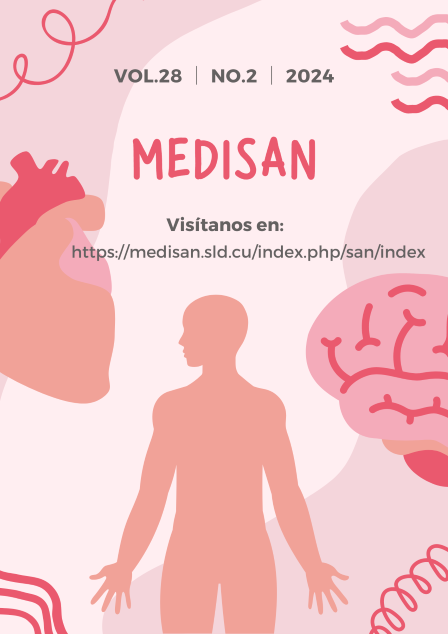Digital visual syndrome in patients under 35 years of age
Keywords:
syndrome, computers, cell phone, vision disorders, asthenopia, ergonomics.Abstract
Introduction: Digital visual syndrome or digital visual fatigue is a disease caused by the ocular fatigue provoked by spending much time in front of a screen.
Objective: To diagnose the digital visual syndrome in patients under 35 years assisted in the refraction service.
Methods: A prospective descriptive and cross-sectional study of patients assisted in the refraction service of the Specialties Polyclinic in Saturnino Lora Teaching Clinical Surgical Provincial Hospital, was carried out from April to June, 2022.
Results: There was a prevalence of patients aged 26 and 35 and female sex; the most frequent symptoms were visual fatigue, ocular burning, dry eye sensation, closely blurred vision, red eye and headache after visual effort. The most used digital devices were the cellphone and the computer with a time of use from one to three hours, with emphasis in the last one with more than 4 hours. The refractive defects constituted the main cause of visual limitations. The patients with digital visual syndrome and some type of ametropia without correction were those with more symptoms, followed by the patients inadequately corrected.
Conclusions: This syndrome affects the youngest population to a great extent. The appropriate interrogation and the incorporation of correct procedures in the daily optometric study allowed the diagnosis of such a syndrome in the assisted patients and the pertinent optic correction.Downloads
References
2. Derbew H, Nega A, Tefera W, Zafu T, Tsehaye K, Haile K, et al. Assessment of Computer Vision Syndrome and Personal Risk Factors among Employees of Commercial Bank of Ethiopia in Addis Ababa, Ethiopia. J Environ and Public Health. 2021 [citado 05/05/2023];2021:6636907. Disponible en: https://www.ncbi.nlm.nih.gov/pmc/articles/PMC8121571/pdf/JEPH2021-6636907.pdf
3. Rueda Mahecha YM, Navarro Gómez CS, Hernández Rodríguez MR, Gómez Prada FE, Silva Giraldo CA. El síndrome de visión por computador – SVI. ITEES. 2020 [citado 09/05/2023];3(3):244-69. Disponible en: https://revistaseidec.com/index.php/ITEES/article/download/47/46/99
4. American Optometric Association. Illinois: AOA; ©2024 [citado 13/2/2022]. Computer Vision Syndrome. Disponible en: https://www.aoa.org/healthy-eyes/eye-and-vision-conditions/computer-vision-syndrome?sso=y
5. Silva Sánchez DC, Montenegro G, Gomez N, Giraldo E. Síndrome Visual Informático en trabajadores que usan computador. Revista Colombiana de Salud Ocupacional. 2021 [citado 09/05/2023];11(1):e-7237. Disponible en: https://revistas.unilibre.edu.co/index.php/rc_salud_ocupa/article/download/7237/6955/24558
6. Seguí Crespo M, Cantó Sancho N, Sánchez Brau M, Davó Blanes MC, Martínez JM, Caballero P. CVS-Qteen©: síndrome visual informático en adolescentes y su relación con los libros de textos digitales. Gaceta Sanitaria. 2022 [citado 09/06/2023];37. Disponible en: https://www.sciencedirect.com/science/article/pii/S0213911122001601#sec0050
7. Todo sobre visión. Dallas: All about visión; ©2000-2024 [actualizado 02/11/2020; citado 09/06/2023]. Heiting G, Wan LK. Síndrome visual informático. Síntomas y tratamiento. 2020. Disponible en: https://www.allaboutvision.com/es/sindrome-visual-informatico/fatiga-ocular-digital/
8. Kovac M, van der Weel A. Lectura en papel vs lectura en pantalla. Bogotá: Centro Regional para el Fomento del Libro en América Latina y el Caribe, Cerlalc-Unesco; 2020. [citado 09/05/2023]. Disponible en: https://cerlalc.org/wp-content/uploads/2020/04/Cerlalc_Publicaciones_Dosier_Pantalla_vs_Papel_042020.pdf
9. Custodio Sanchez K. Transcendence of computer vision syndrome due to prolonged exposure to electronic devices. Revista de la Facultad de Medicina Humana. 2021 [citado 23/06/2023];21(2):462-4. Disponible en: https://inicib.urp.edu.pe/cgi/viewcontent.cgi?article=1332&context=rfmh
10. Estrada Araoz EG, Paricahua Peralta JN. Síndrome visual informático: un problema emergente durante la emergencia sanitaria por COVID-19. Revista Brasileira de Educação do Campo. 2022 [citado 23/06/2023];7,e14516:1-6. Dipsponible en: https://doi.org/10.20873/uft.rbec.e14516
11. Verdezoto Espinoza E, Cabezas Heredia E. Determinación de la fatiga visual y su relación con el teletrabajo en el personal administrativo de la facultad de Ingeniería de la Universidad Nacional de Chimborazo: Caso práctico. Anatomía Digital. 2021 [citado 23/06/2023];4(3.1):149-62. Disponible en: https://www.cienciadigital.org/revistacienciadigital2/index.php/AnatomiaDigital/article/download/1909/4732
12. Gerena Pallares LC, Vargas Rodríguez LJ, Niño Avendaño CA, Camila Uyaban G, Ballesteros Virgen Y. Prevalencia del síndrome visual por computadora en los estudiantes de medicina de la ciudad de Tunja durante la pandemia. RCSO. 2022 [citado 23/06/2023];12(1):e-7916. Disponible en: https://revistas.unilibre.edu.co/index.php/rc_salud_ocupa/article/download/7916/7977/25412
13. Quispe Torres DLJ. Prevalencia y factores asociados al síndrome visual informático en estudiantes de medicina humana del Perú durante la educación virtual por la pandemia del COVID-19 [tesis]. Lima: Universidad Ricardo Palma; 2021. [citado 23/06/2023]. Disponible en: https://repositorio.urp.edu.pe/bitstream/handle/20.500.14138/3608/DQUISPE.pdf?sequence=1&isAllowed=y
14. Instituto Nacional de Estadística e Informática. Estadísticas de las Tecnologías de Información y Comunicación en los Hogares. Informe Técnico No 1 - marzo 2017. Lima: INEI. 2017 [citado 23/06/2023]. Disponible en: https://www.inei.gob.pe/media/MenuRecursivo/boletines/01-informe-tecnico-n01_tecnologias-de-informacion-oct-nov-dic2016.pdf
15. Muñoz Gómez WA. Terapia visual y el síndrome de usuario del ordenador. Castellón de la Planta: Sede de Escuela de Formación Superior SAERA [citado 09/06/2023]. Disponible en: https://www.saera.eu/terapia-visual-y-el-sindrome-de-usuario-del-ordenador/
16. Abudawood GA, Ashi HM, Almarzouki NK. Computer Vision Syndrome among Undergraduate Medical Students in King Abdulaziz University, Jeddah, Saudi Arabia. Journal of Ophthalmology. 2020 [citado 17/12/2020];2020:1-7. Disponible en: https://downloads.hindawi.com/journals/joph/2020/2789376.pdf
17. Huapaya Caña YA. Validación del instrumento “Computer Vision Syndrome Questionnaire (CVS-Q)” en el personal administrativo en Lima 2019 [tesis]. Lima: Universidad Peruana Cayetano Heredia; 2020 [citado 23/06/2023]. Disponible en: https://repositorio.upch.edu.pe/bitstream/handle/20.500.12866/8531/Validacion_HuapayaCana_Yessenia.pdf?se
18. Fernandez Villacorta DE. Prevalencia del síndrome visual informático en estudiantes universitarios de postgrado de una universidad privada Lima-2019 [tesis]. Lima: Universidad Peruana Union; 2019 [citado 23/06/2023]. Disponible en: https://repositorio.upeu.edu.pe/bitstream/handle/20.500.12840/1633/Daniel_Tesis_Licenciatura_2019.pdf?sequence=1&isAllowed=y
19. Ulloa Oliva S, Pazmiño Almendáriz TE, Real Celleri AC, Correa Rojas O. Caracterización del síndrome de ojo seco en la empresa Empac Machine. Revista Metropolitana de Ciencias Aplicadas. 2020 [citado 23/06/2023];3(3);89-97. Disponible en: http://remca.umet.edu.ec/index.php/REMCA/article/download/314/338
20. Gammoh Y. Digital Eye Strain and Its Risk Factors among a University Student Population in Jordan: A Cross-Sectional Study. Cureus. 2021 [citado 23/06/2023];13(2):e13575. Disponible en: https://assets.cureus.com/uploads/original_article/pdf/52884/20210329-19820-10j6q7q.pdf
Published
How to Cite
Issue
Section
License
All the articles can be downloaded or read for free. The journal does not charge any amount of money to the authors for the reception, edition or the publication of the articles, making the whole process completely free. Medisan has no embargo period and it is published under the license of Creative Commons, International Non Commercial Recognition 4.0, which authorizes the copy, reproduction and the total or partial distribution of the articles in any format or platform, with the conditions of citing the source of information and not to be used for profitable purposes.





